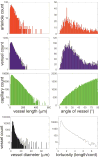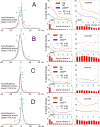The impact of vessel size, orientation and intravascular contribution on the neurovascular fingerprint of BOLD bSSFP fMRI
- PMID: 28890417
- PMCID: PMC5857886
- DOI: 10.1016/j.neuroimage.2017.09.015
The impact of vessel size, orientation and intravascular contribution on the neurovascular fingerprint of BOLD bSSFP fMRI
Abstract
Monte Carlo simulations have been used to analyze oxygenation-related signal changes in pass-band balanced steady state free precession (bSSFP) as well as in gradient echo (GE) and spin echo (SE) sequences. Signal changes were calculated for artificial cylinders and neurovascular networks acquired from the mouse parietal cortex by two-photon laser scanning microscopy at 1 μm isotropic resolution. Signal changes as a function of vessel size, blood volume, vessel orientation to the main magnetic field B0 as well as relations of intra- and extravascular and of micro- and macrovascular contributions have been analyzed. The results show that bSSFP is highly sensitive to extravascular and microvascular components. Furthermore, GE and bSSFP, and to a lesser extent SE, exhibit a strong dependence of their signal change on the orientation of the vessel network to B0.
Keywords: Balanced SSFP; Extra- and intravascular contribution; Layer specific BOLD fMRI; Orientation-dependent BOLD fMRI; Vascular cortical network.
Copyright © 2017 The Authors. Published by Elsevier Inc. All rights reserved.
Figures








References
-
- Bieri O, Scheffler K. Effect of diffusion in inhomogeneous magnetic fields on balanced steady-state free precession. NMR Biomed. 2007;20:1–10. - PubMed
-
- Blockley NP, et al. Field Strength Dependence of R1 and R*2 Relaxivities of Human Whole Blood to ProHance, Vasovist, and Deoxyhemoglobin. Magn. Reson. Med. 2008;60:1313–1320. - PubMed
-
- Bowen CV, et al. High field balanced-SSFP FMRI: a BOLD technique with excellent tissue sensitivity and superior large vessel suppression. Proc 13th ISMRM; Miami. 2005. p. 119.
Publication types
MeSH terms
Substances
Grants and funding
LinkOut - more resources
Full Text Sources
Other Literature Sources

